Design.bio
Bringing biology to the design studio.
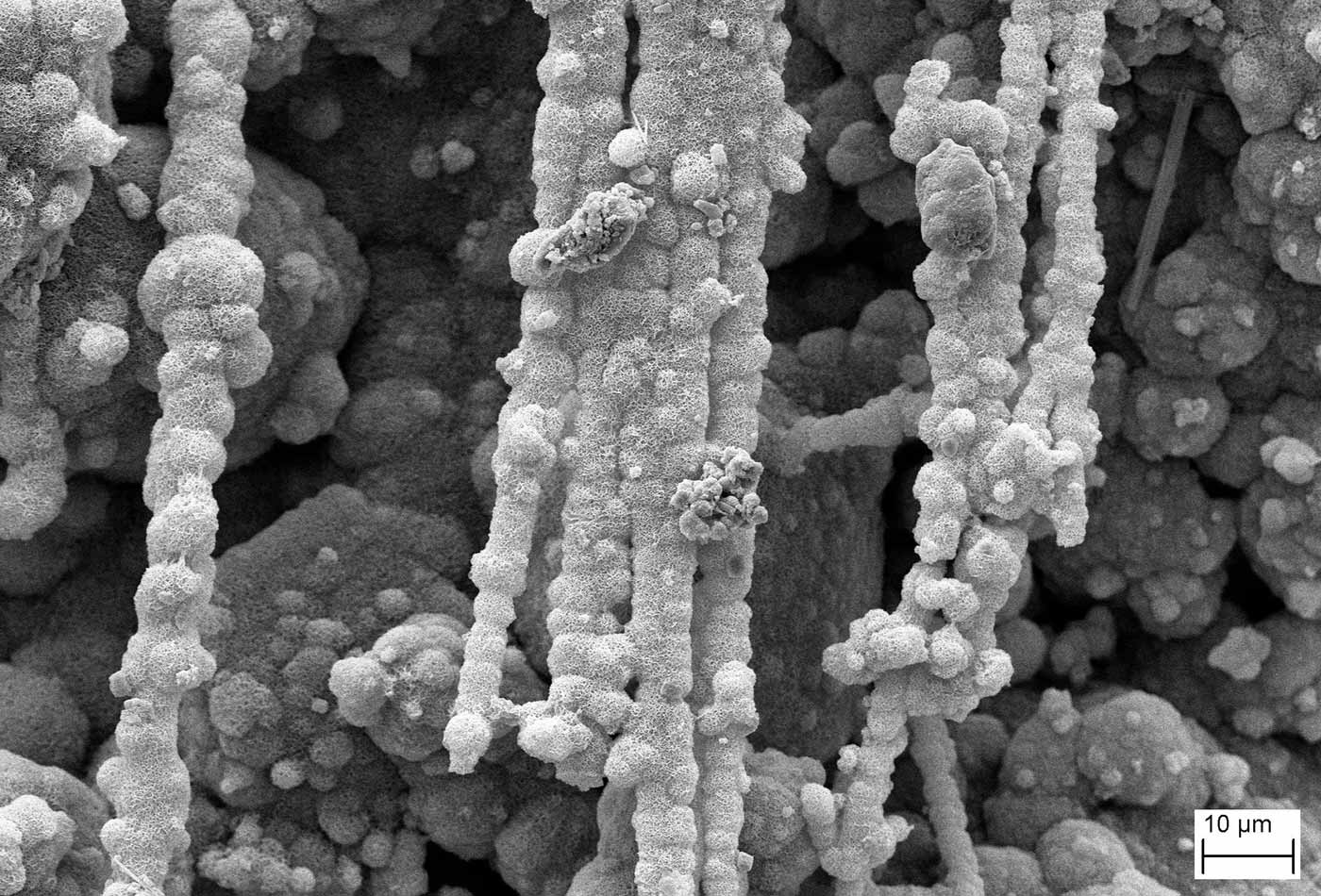 This SEM image shows formation of a crack bridging for self-healing in concrete. (source: Engineering at Cambridge on Flickr)
This SEM image shows formation of a crack bridging for self-healing in concrete. (source: Engineering at Cambridge on Flickr)
As scientists’ understanding and ability to manipulate biological systems have improved, there is growing interest in the design community to work with synthetic biology and biological design. In the hands of speculative designers, bacteria is turning into gold, furniture is grown out of mushrooms, specs of meat become leather jackets or discussed in cooking shows. Many of these bold ideas are realized as creative design statements or symbolic gestures that make us think about the cultural and environmental implications of working with biology. Sometimes due to the limits in knowledge or resources—or simply by intention—these designs do not become part of everyday life and remain as intellectual endeavors featured in books, exhibitions, or competitions. This disconnect gives such designs the ability to be radical, unconstrained from regulations, feasibility, cost, or market demands. In return, however, they gain the power to shape public opinion, create discussion and debate, and inspire many more designers to work with biology.
On the other hand, there is a growing community of designers who would like to see biology as part of their practices in architecture, fashion design, food design, and so on (Figure 1-1). Biology for them is not a new niche or a realm for speculation, but rather a radical rethinking of aesthetics and manufacturing to eliminating pollution, addressing labor abuse, and income equality. The products that emerge from this mindset are on their way to becoming probiotic cosmetics, self-healing concrete, cow free-milk, or spider silk that can be woven into clothing. Unlike speculative design, these ideas are measured against pragmatics, safety concerns, and regulations. They are vetted by business models, market trends, or investor preferences like every other product that matters in our lives. They must consider safety and they are subject to regulations.
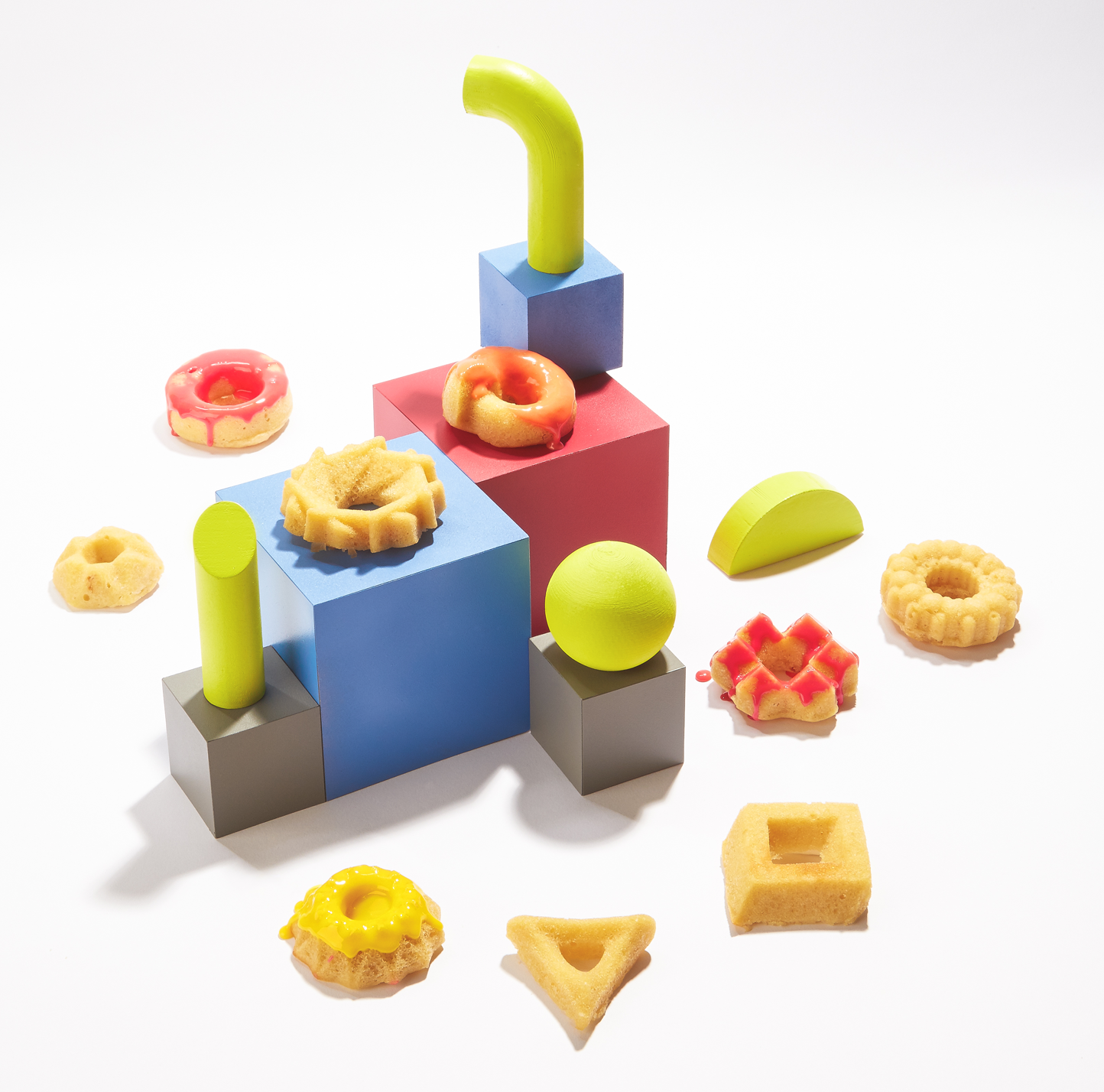
Today, there is a disparity between the growing demand to use biology and access to the resources to practice it safely outside academic institutions. Biological materials and knowledge are becoming increasingly available at informal learning centers—makerspaces, science museums, or community labs—but even at those places designers have to invest significant time and energy to learn biology and gain the skills to be able to do the simplest experiments.
Designers are often expected to become capable amateur biologists before applying biology. Learning biology in this way is a daunting task, particularly when design possibilities are unavoidably vague at the outset; it requires some knowledge of biology to know what is possible, and some knowledge of what is possible to begin the process of designing. For science and engineering students, learning the basic principles of working with living organisms may suffice. But it is harder for design students to engage with the abstract world of organisms, which all look indifferent to the eye in small vials and test tubes, without having the necessary means to culture them. Learning how to make bacteria smell like bananas or emit fluorescent colors are attractive first steps, but maintaining the interest often proves to be difficult if designers cannot directly apply their knowledge to a domain they already know. Architects, for example, usually do not learn programming by studying computer science. They learn it as as part of their architecture education. Coding is incorporated into parametric design tools where modeling and fabrication processes are scripted. Designers see the immediate application of their knowledge as part of their design, whether it is modeling a car or generating patterns for fabrics. Designers also need to see biology in form and action—as materials or applications—that can sketched, prototyped, tested in iterations.
It is important for designers to engage with biology in a lab and understand the sceptic and labor-intensive culture of working with life. Yet design almost always happens in studios where computers, software, and various prototyping tools—laser cutters, plotters, 3D printers—work next to one another. These tools help us quickly test ideas in various forms and get feedback. More importantly they connect us to the large world of resources—images, fonts, code, 3D models, circuit designs—that are created by others can quickly be incorporated into our designs. The diversity of these resources is the very DNA of design studios in which ways to work with biology are currently absent, but increasingly on demand.
Microbial Design Studio brings biology to the design studio. It is a design tool that minimizes the learning curve to work with biology to create sufficiently complex applications in food, material, fashion, graphic design, or architecture. The studio functions as a portable wetlab that automates the design and prototyping process of working with microorganisms such as yeast and E.coli. Designers can grow these organisms to synthesize new chemicals and use the chemicals or the organisms directly as part of sensing and remediation applications (Figure 1-2).
Designers load bacteria and DNA from one end and receive their incubated products—such as food ingredients, dyes, limestone, or biopolymers, or biosensors—on the other end. They can immediately combine the bioproducts or the organisms with their designs at the studio. MDS let designers work with CRISPR and other advanced gene editing technologies to directly manipulate genomes. However, in addition to genetically transforming organisms, the tool can be used to combine different organisms to design microbial communities, which can then be tested in the development of foods and flavors or in microbiome work. Designers can use the platform to analyze the microbial signatures of built environments and explore ways to design biofilms that can be incorporated to architecture, furniture, and objects that will yield beneficiary results to the users.
MDS is a combinatorial and parametric design tool. It allows designers to make experiments in which they can insert different combinations of gene sequences to different microorganisms to try multiple designs at the same time. After the DNA is inserted to the bacteria, the designs can be manipulated further through adding nutrients, reagents, and media, or by controlling incubation conditions by varying temperature or oxygen intake. The automation process eliminates the need for manual labor in moving liquid across different devices to transform, incubate, purify, and measure outcomes at different stages. Designs are monitored in a single workflow through sensors that measure growth and check whether the intended features are realized or not. The outcomes of every experiment are recorded and stored on a website where they can be visualized, historicized, and shared with others.
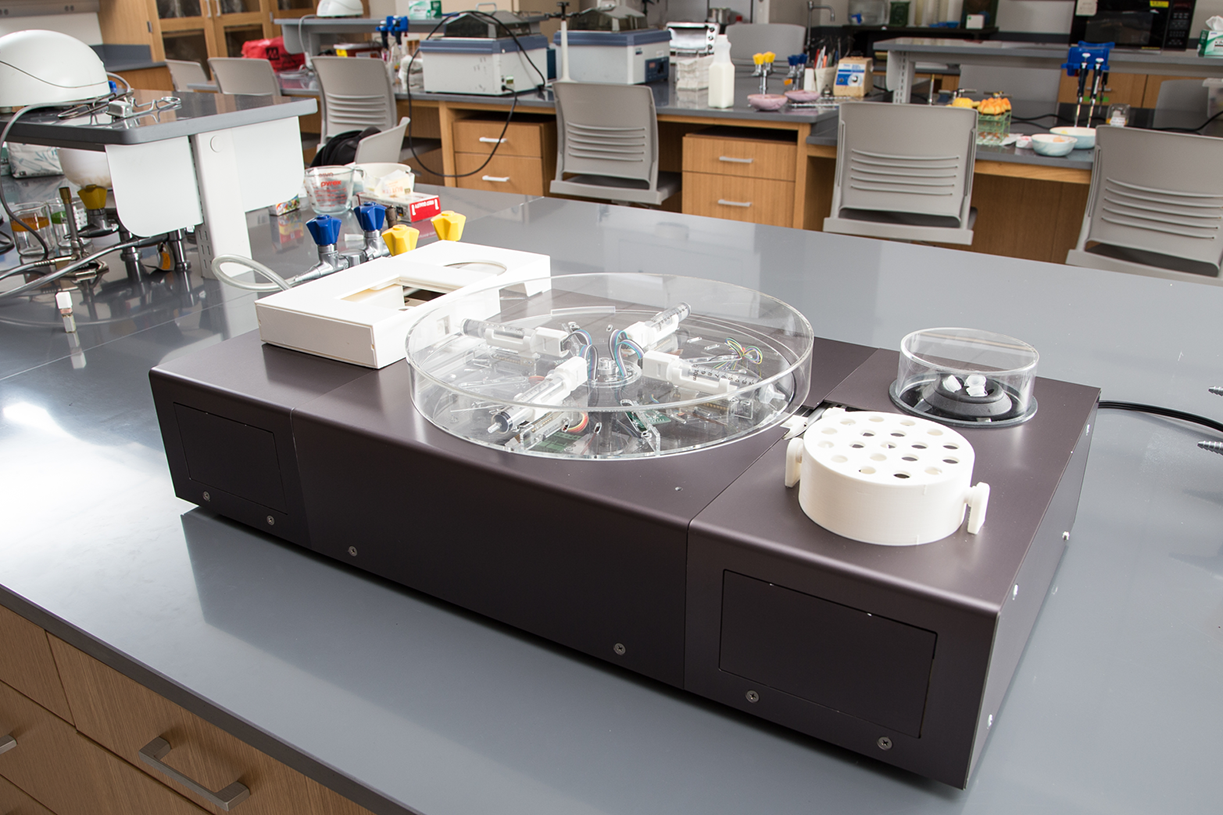
The platform also connects to other machines and an online repository in which different protocols—or design recipes—can be downloaded to the machine. This feature allows designers to replicate an existing design that is already verified by other designers or experts. A network of design studios can also be programmed to work together to produce more of the same bioproduct or its variations, such that machines can work on distributed experiments.
MDS is distributed by Design.bio, a web portal that focuses on simplifying workflows for designing with biology by providing the tutorials, consumables, and control protocols for Microbial Design Studio. The site works as a content hub to demonstrate what designers can achieve with MDS.
One common problem biological designers experience is a lack of design examples that are simple enough to try on their own or in community labs. There are now kits, curricula (e.g., BioBuilder), and incubation platforms (e.g., Amino) on the market that can help new audiences learn about the basic principles of genetics or synthetic biology. We want to complement these efforts by making biology accessible to the design market. Our goal is to simplify the processes of working with biology such that product and fashion designers and architects can immediately start working from examples and quickly develop their own ideas. Instead of spending years learning advanced levels of biology and complex, manual techniques such as pipetting, designers can focus on applications by building on existing designs in much the same way that electronics designers accelerate their work by using circuitry examples or programmers quickly develop code by building on source code samples. Manipulating existing examples is a great way of customizing designs for new applications as well as expanding knowledge in creative fields.
Today, when new applications are introduced to the community—through videos, research papers, or online write-ups—it is often very difficult to get the information and know-how. The limits of knowledge and the lack of familiarity with the jargon make scientific papers difficult to parse for non-biologists. Even if the protocols are made accessible through video demonstrations and visualizations, it is often difficult to achieve the same outcome, as results obtained through one set of equipment many not necessarily yield the same results through another. Also when manual labor is involved, the process is often prone to mistakes due to lack of skills, handling measurements, liquid, or tasks.
Design.bio streamlines the workflow so that designers have access to a standardized set of consumables, media, organisms, and a hardware platform so they can just focus on realizing their designs. It works like sites that distribute cooking recipes (e.g., molecularrecipes.com) or electronic kits (e.g., Makershed) by becoming a single source for ingredients, equipment, and information necessary to work with biology. Here, designers can order applications created by other designers, who provide example use cases and systematic ways to vary outcomes such that they can be customized for different uses.
While currently the activities are centered on the MDS, we expect that the site will grow beyond a single platform to feature tools and technologies geared toward other domains of biological design initiated by other vendors. We see MDS and Design.bio as first steps to facilitate designer-to-designer interaction and allow the fields of biological design and synthetic biology to gain more traction in the mainstream fields. That’s because product design, fashion, gastronomy, or architecture can harbor many creative and critical applications of working with living organisms.
As an example, I would like to share with you how MDS can be used to design probiotic donuts. This application was designed by Taylor Caputo, a product designer who explores the role of augmented yeast products in food and flavor design.
Microbial Design Studio: Donuts
Making donuts is easy. Simple kitchen ingredients and a standard desktop oven are enough to make exquisite homemade donuts in hundreds of flavors. Donut taste can be customized using different kinds of flour, water, or natural or artificial flavors in the batter; by adding different leavening agents like yeast, baking powder, or soda for rising the dough; or by exploring novel glazings, toppings, or icing.
While it is common to see donuts colorfully designed by foodies, chefs, and the gastronomically inclined, they are not a typical project for product designers, architects, or biologists. We do not often see parametrically designed donuts that vary in form, shape, and structure, or genetically augmented or probiotic donuts that are designed to explore new tastes. Caputo’s microbial donuts demonstrate how new types of food design can be informed by biological concepts as well as combinatorial and parametric design methods that are ubiquitous in architecture and engineering.
Caputo’s approach starts with a basic study of volume and shows how different forms can yield interesting structural qualities inside the donut. She uses Rhino to estimate the structure of the dough based on how much batter can be packed in a single form, and how much the dough can rise based on the organisms in the batter (Figure 1-3). The form of the donut influences the amount of CO2 that can be released inside the dough and how the batter will be distributed inside the form. Her experiment compares four different geometries that are similar in diameter yet vary in heights. She prints the shapes in a standard 3D printer to create molds that can be used to bake the risen dough (Figure 1-4).
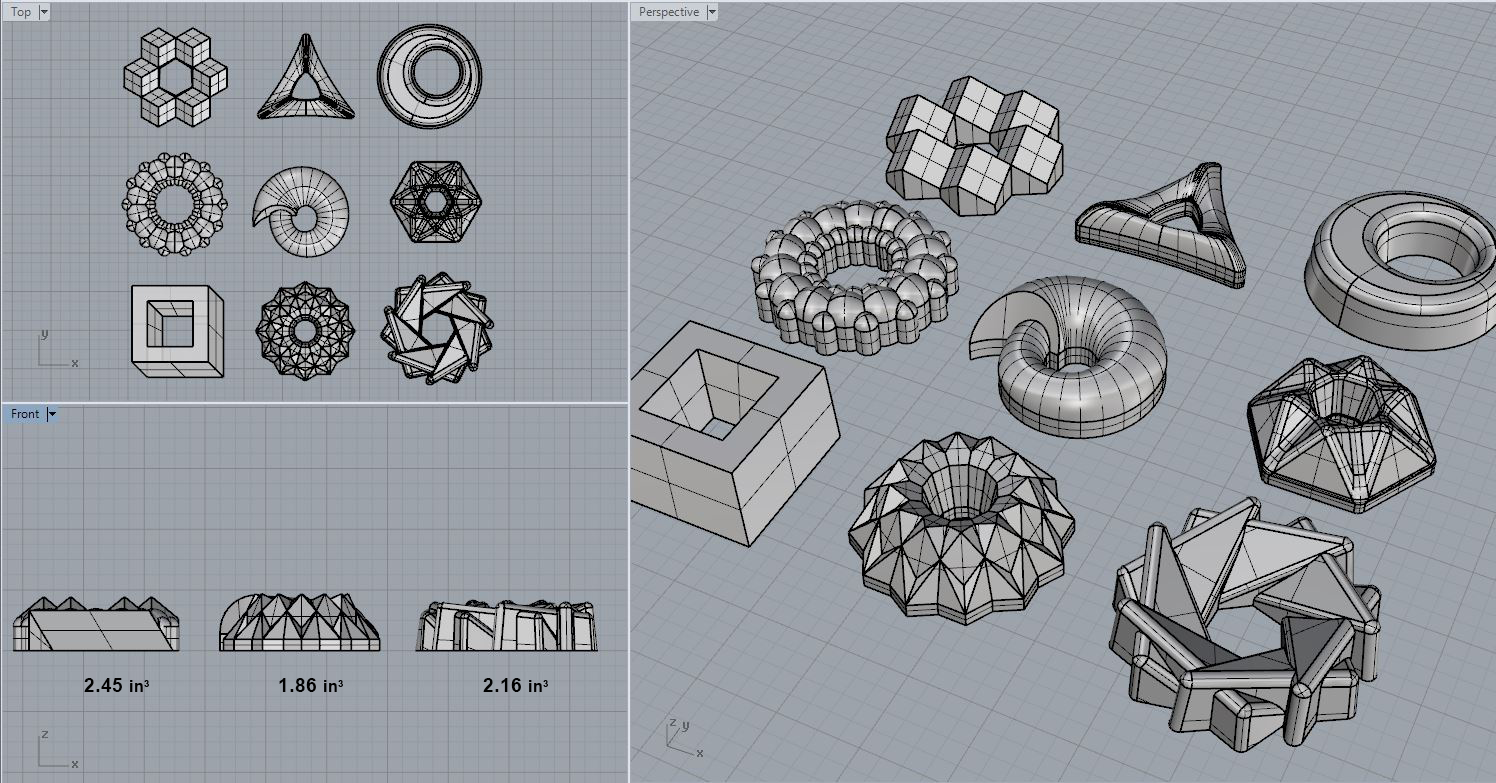
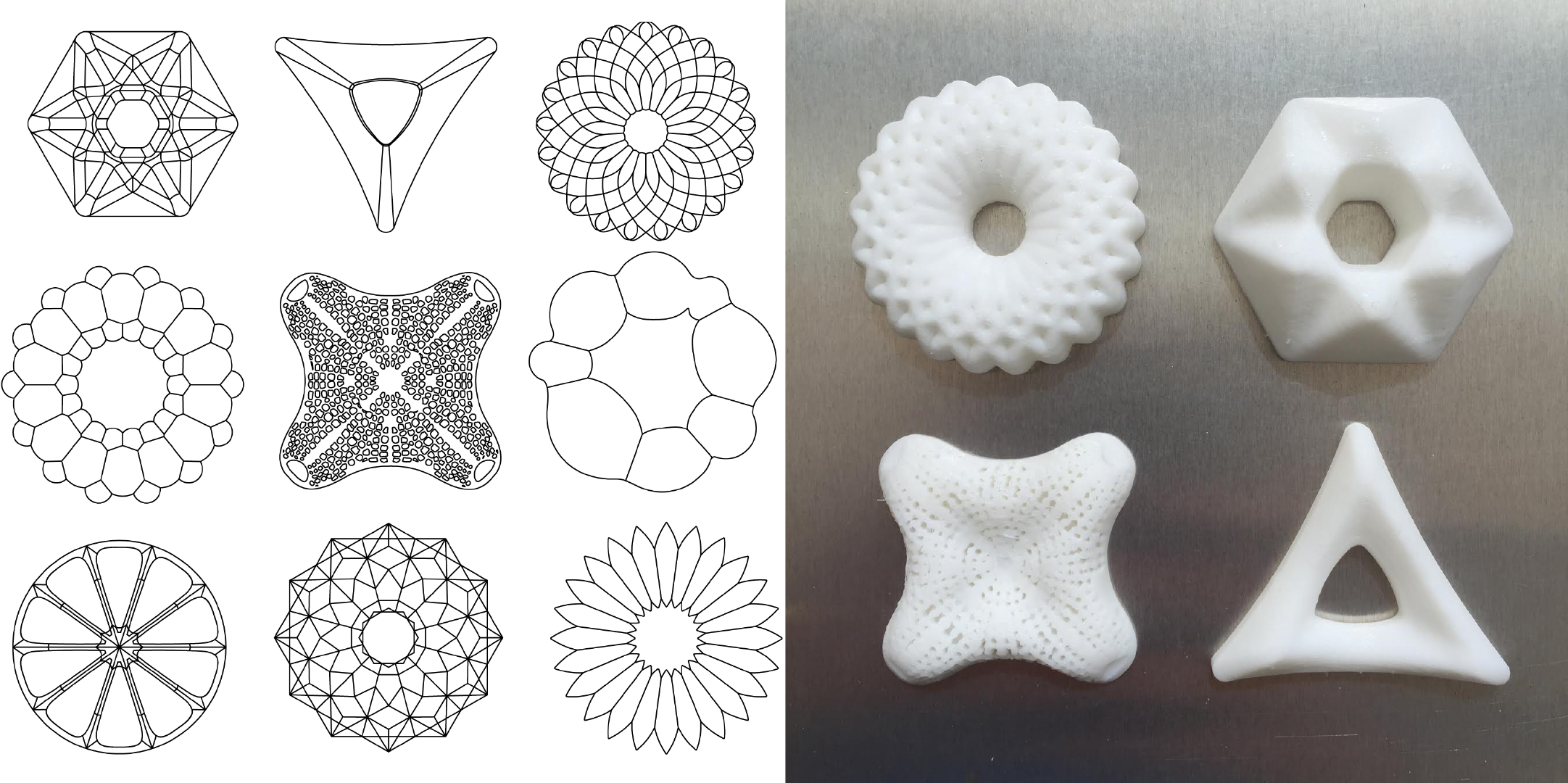
The yeast inside the dough can make a big difference in taste. Commercial yeast cultures use standardized strains, which are generally selected for fast leavening and long shelf life. In the United States and Canada, genetically modified yeast is commonly used to improve performance in industrial production as well as in home bread-making machines. In addition to being optimized for speed, the cultures are manipulated to synthesize ascorbic acid (vitamin C), which can become a preserving agent for the dough when it is produced by the yeast.
In her donuts, Caputo works with golden bread yeast obtained from BioBuilder.1 The yeast (see Figure 1-5 and Figure 1-6) carries a special genome that allows it to produce beta-carotene. This strain is specially designed to create golden bread that addresses vitamin A deficiency in countries where there are high infant mortality rates due to malnutrition. Vitamin A, contained within baked products, is a potentially a reliable source. It does not pose risks to the environment in the way a genetically modified plant could, since the organisms do not interact directly with nature. Instead they are grown in an isolated environment, such as an industrial fermenter similar to those used in beer and cheese production. Once beta-carotene is synthesized, it can be extracted from the organisms through purification methods, after which the organism is safely terminated.
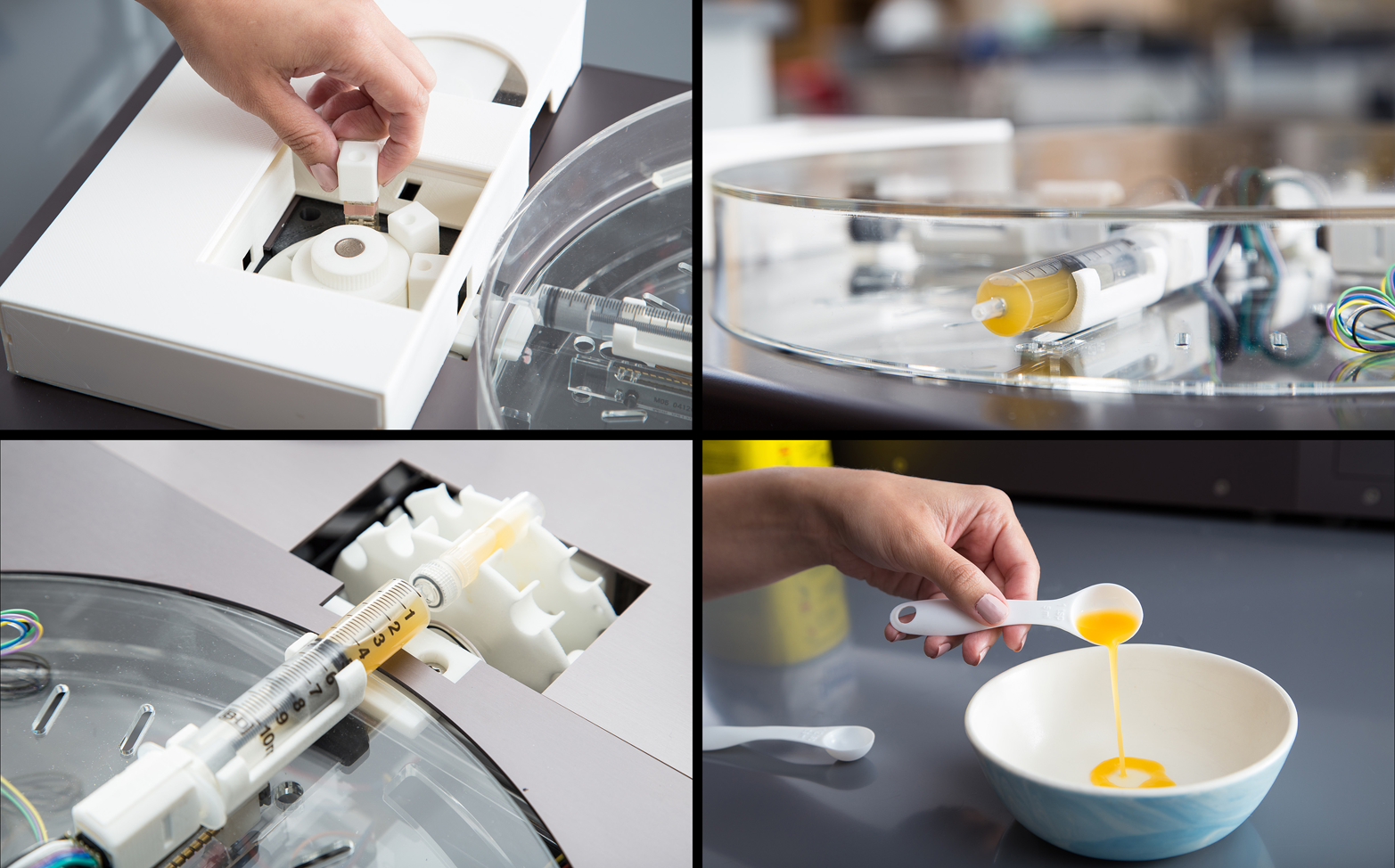
While the golden bread yeast is engineered to produce the color orange, it is genetically unstable and can produce white or red colors as well. An unstable strain or a growth process interrupted before the completion of the metabolic pathway may not yield beta-carotene (orange) but an intermediary molecule such as lycopene, which makes the culture appear red. When grown with MDS, the yeast can be incubated at different temperatures and with different reagents that can speed up or slow down the growth. This process can be driven by algorithms that periodically measure the amount of yeast in the system and terminate the growth based on the desired output.
Golden yeast, on the other hand, is not as efficient as a commercial yeast culture. For a more airy taste, it is better to mix it with more standardized, off-the-shelf baker’s yeast. However, the mixing process can be systematized using MDS by combinatorially mixing different strains at different ratios under different growth conditions. Multiple strains can be simultaneously grown together to do a comparative study to find out which donut will taste better. As the leavened dough is ultimately baked (Figure 1-7 and Figure 1-8), the final donuts are free of any live culture. Unless one saves a batch, there is often no way to save the know-how. Instead of saving a starter culture for the next experiment, MDS can keep track of the analytics. The amount of cultures that are mixed, the type of strains, temperature, and reagents can all be recorded automatically as variables of a recipe that can be used later. These recipes then can be shared with other designers, who can replicate the same taste without shipping any materials.
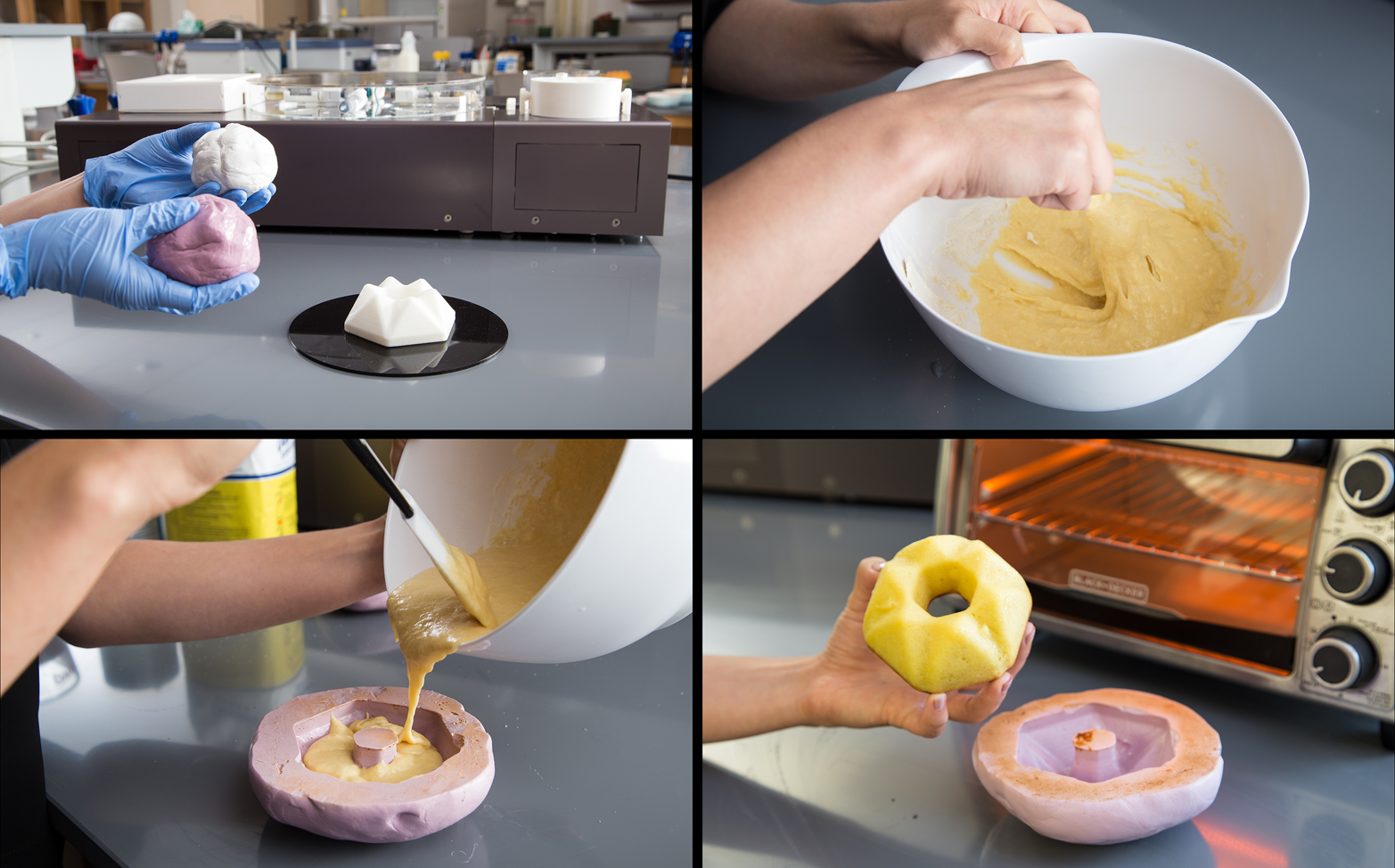
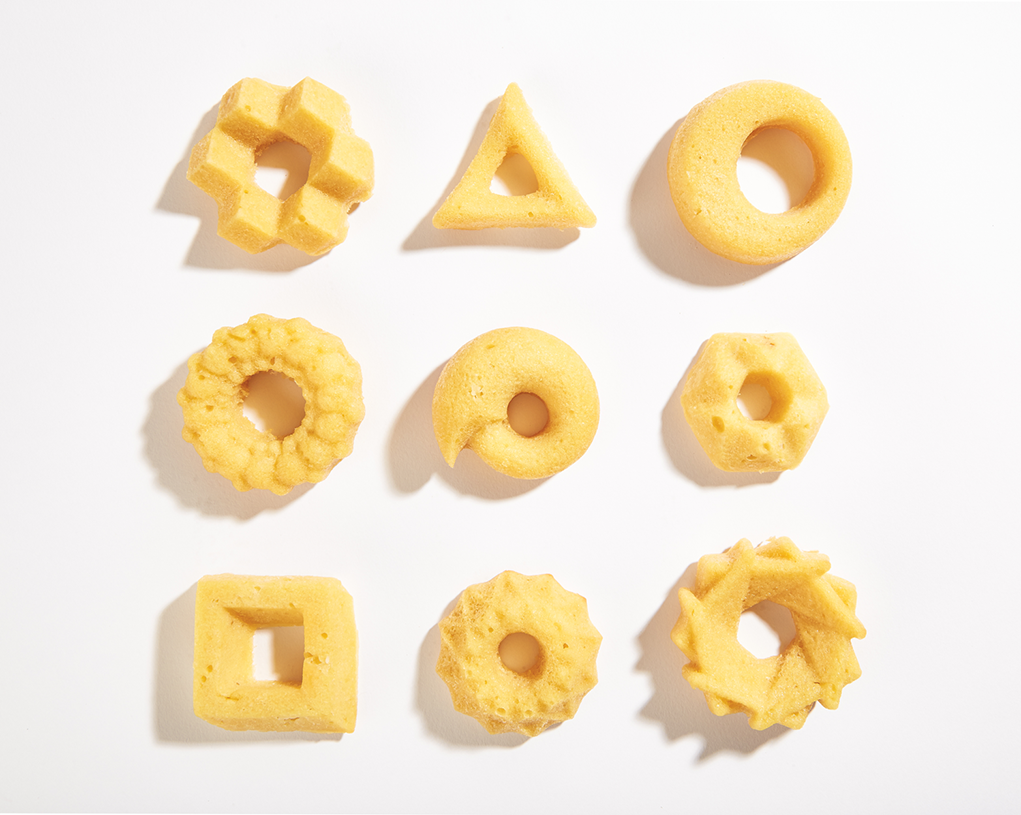
The icing of the donut (Figure 1-9) is the last step of the design process. In addition to choosing from many different kinds of toppings, one could use flavors grown out of various microorganisms. In her application, Caputo demonstrates the use of Farnesol, a sweet smelling compound that is often present in sandalwood oil. She uses a special strain of odor-free E. coli K12 (strain YYC912) sourced from Yale E. coli Genetic Stock Center. The odor-free E. coli is transformed with pMBIS plasmid obtained from Addgene plasmid repository (Plasmid #17817). Like yeast, E. coli K12 is also a non-pathogenic strain, which can be which can be safely handled by the user. The Farnesol producing bacteria can be grown in the MDS and mixed with a sweetened icing to top the golden donut with a sandalwood-like smell.
Caputo’s microbial donuts at this stage are proof of concepts. They have not been evaluated for their taste. Due to regulatory requirements, the donuts cannot be consumed within the University of Pennsylvania, where the experiments are designed. However, the design application will be available in Design.bio with a variety of strains of food-grade yeast and bacteria and combinatorial and parametric design options. In the meantime, the full tutorial of microbial donuts example, ingredients, and design instructions can be found at design.bio/microbialdonuts.
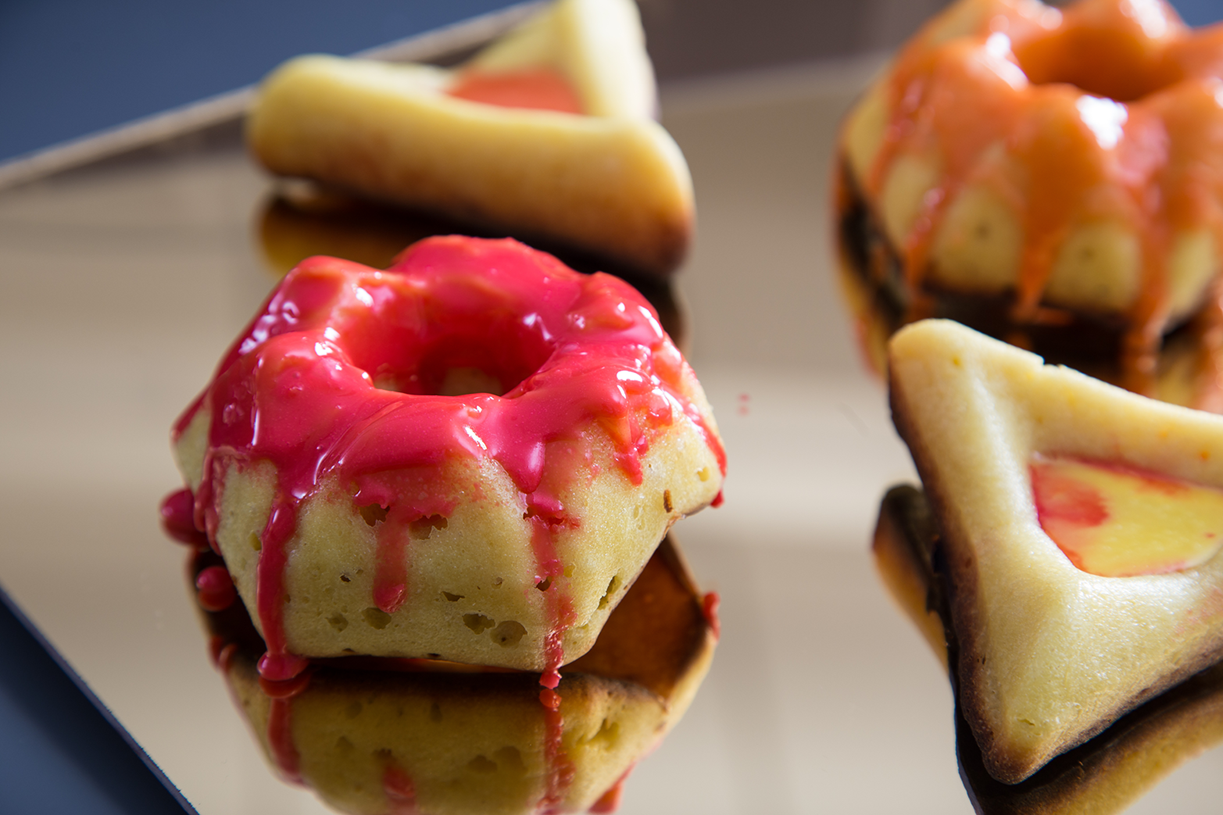
Designers who are interested in participating in Microbial Design Studio’s alpha testing program can also reach us at info@biorealize.com.
1More information about the science behind golden yeast, can be found at http://biobuilder.org/golden-bread-students.
